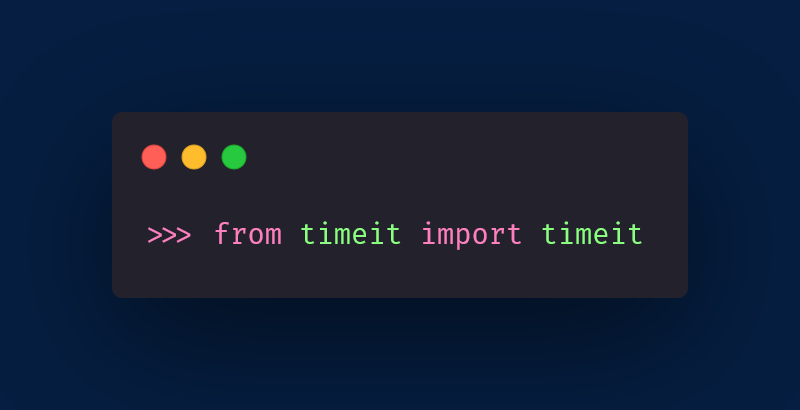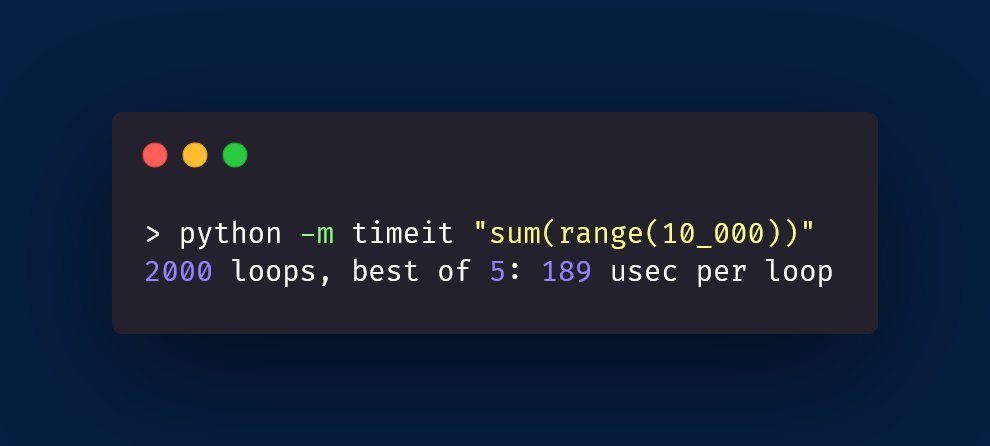Have you ever tried to optimise your Python 🐍 code, but weren't able to tell which alternative implementation was faster?
Let me teach you how to use the `timeit.timeit` method to measure execution time of small code snippets.
A thread 👇🧵
Let me teach you how to use the `timeit.timeit` method to measure execution time of small code snippets.
A thread 👇🧵

If you have a snippet of code you want to time, you can use the command line to measure its execution time.
For example, how long does it take for Python 🐍 to add up the first 10,000 integers?
Using the command `python -m timeit`, I get that it takes 189 microseconds.
For example, how long does it take for Python 🐍 to add up the first 10,000 integers?
Using the command `python -m timeit`, I get that it takes 189 microseconds.

The execution of `python -m timeit` reports some more info:
“2000 loops, best of 5: ...”
I'll explain what that means, but first let me show you how to use `timeit` in your code.
(Oh, btw, there's a MUCH better way to add consecutive integers! 👇)
“2000 loops, best of 5: ...”
I'll explain what that means, but first let me show you how to use `timeit` in your code.
(Oh, btw, there's a MUCH better way to add consecutive integers! 👇)
https://twitter.com/mathsppblog/status/1427256481796218880
Oh, did I tell you that the `timeit` module is in the standard library? No extra installs needed.
`timeit.timeit` accepts the piece of code you want to time and returns the number of seconds it took to run.
In the REPL, summing the first 10,000 integers takes... 259 seconds⁉
`timeit.timeit` accepts the piece of code you want to time and returns the number of seconds it took to run.
In the REPL, summing the first 10,000 integers takes... 259 seconds⁉

That's only because the `timeit` function accepts a keyword argument `number`, that specifies the number of times your code is going to be ran.
The default value is 1,000,000 (one million) which can be quite huge!
If you want to time things that take longer, change the default!
The default value is 1,000,000 (one million) which can be quite huge!
If you want to time things that take longer, change the default!

So, when we used the CLI with `python -m timeit ...` and the program said
“2000 loops, ...”
what that meant was that `number` was set to `2000`.
Let's try setting `number` to 2000 ourselves and compare the CLI result with the REPL result 👇
“2000 loops, ...”
what that meant was that `number` was set to `2000`.
Let's try setting `number` to 2000 ourselves and compare the CLI result with the REPL result 👇

The REPL clocked 0.51s for 2000 repetitions, giving 255µs to run `sum(range(10_000))`.
255µs is 35% times slower than 188µs!
Why such a big difference?
That's why the CLI includes the “..., best of 5: ...”!
Your PC has many processes running that impact performance...
255µs is 35% times slower than 188µs!
Why such a big difference?
That's why the CLI includes the “..., best of 5: ...”!
Your PC has many processes running that impact performance...
To try and work around that, the CLI ran the whole experiment a total of 5 times and took the fastest time.
We take the fastest time (and not the mean) because we can interpret that value as the experiment where the other processes interfered less.
Is this making sense, so far?
We take the fastest time (and not the mean) because we can interpret that value as the experiment where the other processes interfered less.
Is this making sense, so far?
So, if we want to reproduce the CLI results better, we need to run the REPL experiment 5 times and look for the best result.
Now, the fastest repetition clocked in at 0.393s for 2000 reps, giving ~197µs for the snippet...
197µs is much closer to 188µs!
Now, the fastest repetition clocked in at 0.393s for 2000 reps, giving ~197µs for the snippet...
197µs is much closer to 188µs!

Alternatively, we can use the `timeit.repeat` method and make use of the `repeat` keyword argument.
The `repeat` method will return a list with all the times, it is then up to you to compute the `min` of that list.
The `repeat` method will return a list with all the times, it is then up to you to compute the `min` of that list.

I hope all of this is making sense so far.
Up to this point, you've learned how to use `timeit` from the command line, you've learned about `timeit.timeit(code, number=1000000)` and you've learned about `timeit.repeat(..., repeat=5)`.
Let's explore `timeit.timeit` a bit more.
Up to this point, you've learned how to use `timeit` from the command line, you've learned about `timeit.timeit(code, number=1000000)` and you've learned about `timeit.repeat(..., repeat=5)`.
Let's explore `timeit.timeit` a bit more.
Suppose you want to see how fast the built-in factorial function, `math.factorial`, is.
For that, let's just use `timeit.timeit` 👇
Why do we get a `NameError`??
Because `timeit` runs the snippet in a blank environment, akin to a `.py` script that ONLY contains the snippet.
For that, let's just use `timeit.timeit` 👇
Why do we get a `NameError`??
Because `timeit` runs the snippet in a blank environment, akin to a `.py` script that ONLY contains the snippet.

Ah, no problem, this is easy to fix.
Especially if you know that Python 🐍 can use semicolons `;` to separate statements, like I've shown you here 👇
Especially if you know that Python 🐍 can use semicolons `;` to separate statements, like I've shown you here 👇
https://twitter.com/mathsppblog/status/1435017440648384515
But wait!
Now the `timeit` function is _also_ timing the import statement, which is NOT what we want!
That's why the methods `timeit` and `repeat` accept a `setup` keyword argument.
`setup` specifies a piece of code that prepares the environment, e.g. with necessary imports.
Now the `timeit` function is _also_ timing the import statement, which is NOT what we want!
That's why the methods `timeit` and `repeat` accept a `setup` keyword argument.
`setup` specifies a piece of code that prepares the environment, e.g. with necessary imports.

Making proper usage of the `setup` keyword argument lets you measure time execution more accurately.
By removing a simple `import` statement, the time measured decreased by 24% and now represents a more accurate measurement.
Nicely done!
By removing a simple `import` statement, the time measured decreased by 24% and now represents a more accurate measurement.
Nicely done!
Now we want to compare the built-in `math.factorial` to my home-made `fact` function, using `reduce` and `operator.mul`.
First, a quick check showing that my home-made `fact` produces the correct results:
First, a quick check showing that my home-made `fact` produces the correct results:

Now we can time the function, we just need to build the proper setup string...
But that's going to be a huge string!
Wouldn't it be nice if you could just tell `timeit` where to look for the `fact` name..?
You can!
That's what the `globals` argument is for 👇
But that's going to be a huge string!
Wouldn't it be nice if you could just tell `timeit` where to look for the `fact` name..?
You can!
That's what the `globals` argument is for 👇

In general, you can save yourself some trouble if you use the `globals()` Python 🐍 built-in, which is a dictionary that contains all the global names that Python knows of that are _not_ built-ins.
This makes it more convenient to specify many objects:
This makes it more convenient to specify many objects:

These are just some of the cool things you can do with the standard module `timeit`!
Recap:
👉 use `python -m timeit <code>` to measure execution time of a simple snippet in the CL
👉 use `timeit.repeat` to mimic the CLI behaviour
👉 use `timeit.timeit` for one-off measurements
Recap:
👉 use `python -m timeit <code>` to measure execution time of a simple snippet in the CL
👉 use `timeit.repeat` to mimic the CLI behaviour
👉 use `timeit.timeit` for one-off measurements
`.repeat` and `.timeit` accept some keyword arguments:
👉 `number`: how many times to run the code
👉 `setup`: set up the environment
👉 `globals`: dict with names needed (useful: the `globals()` built-in)
👉 `.repeat` also accepts `repeat` to produce more accurate measurements
👉 `number`: how many times to run the code
👉 `setup`: set up the environment
👉 `globals`: dict with names needed (useful: the `globals()` built-in)
👉 `.repeat` also accepts `repeat` to produce more accurate measurements
I hope you enjoyed this thread, a LOT of effort was put into this!
If you did, follow me (@mathsppblog) for more content like this.
Consider sharing the beginning of the thread to share your support and appreciation for my work and for Python 🐍!
If you did, follow me (@mathsppblog) for more content like this.
Consider sharing the beginning of the thread to share your support and appreciation for my work and for Python 🐍!
https://twitter.com/mathsppblog/status/1435670883167883266
If you would like to level up your Python 🐍 game, you should definitely subscribe to my newsletter 📬, to receive gold nuggets of Python knowledge 🧠
You also get to know, first hand, when I publish my in-depth Python articles on my blog.
Subscribe:
mathspp.com/subscribe
You also get to know, first hand, when I publish my in-depth Python articles on my blog.
Subscribe:
mathspp.com/subscribe
• • •
Missing some Tweet in this thread? You can try to
force a refresh



![Diagram showing how you can use f-strings and their format specification to redact private or sensitive information, like email addresses. The code from the diagram: def redact_email(email): user, _, domain = email.partition("@") return f"{user[:2]:*<{len(user)}}@{domain}" print(redact_email("rodrigo@mathspp.com")) # ro*****@mathspp.com](https://pbs.twimg.com/media/GqhlkWbXgAAE9kd.jpg)

















